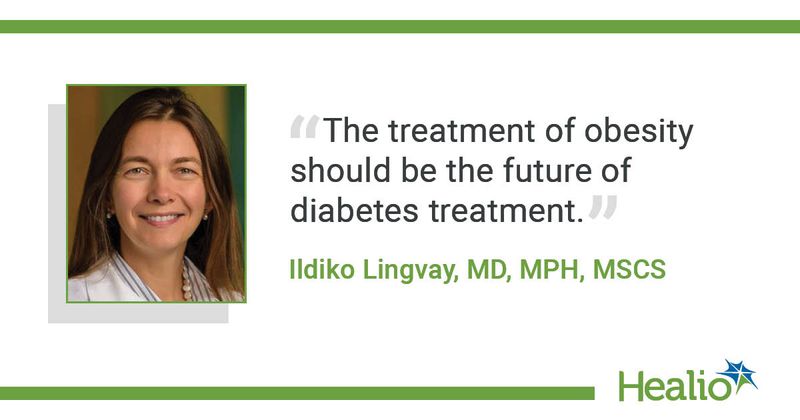Weight loss of 15% should be primary goal for most people with type 2 diabetes
Losing 15% of body weight should be a primary treatment goal for most people with type 2 diabetes and could help lead to diabetes remission, according to two speakers.
Ildiko Lingvay, MD, MPH, MSCS, a professor of medicine at the University of Texas Southwestern Medical Center in Dallas, and Priya Sumithran, MBBS (Hons), FRACP, PhD, a senior research fellow in the department of medicine at the University of Melbourne in Australia, said health care professionals treating people with diabetes should be trained in obesity management to prepare for a future of diabetes treatment where weight loss is a major focus.

“The treatment of obesity should be the future of diabetes treatment,” Lingvay said during a press conference at the European Association for the Study of Diabetes virtual meeting. “It is now our responsibility to work at making it the present of diabetes treatment.”
According to estimates included in a review article published in The Lancet, 40% to 70% of people with type 2 diabetes have obesity, and about 20% to 40% have cardiovascular disease. This leads to three subgroups of people with type 2 diabetes: adiposity-related diabetes, diabetes with CVD and isolated hyperglycemia. Lingvay said treatment should be tailored specifically toward those subtypes.
“We propose a gluco-centric approach for those with beta-cell dysfunction and isolated hyperglycemia, a cardio-centric approach in those with CVD, and a weight-centric approach in everybody else,” Lingvay said.
Weight loss of 15% as primary goal
In the review article, researchers detailed specific targets for each of the three diabetes subtypes. For isolated hypoglycemia, the primary target should be an HbA1c of less than 7%. For diabetes with CVD, treatment should center on the use of proven cardio-protective agents. For adiposity-related diabetes, adults should aim for 15% or more weight loss. Adiposity-related diabetes should center around weight-loss interventions and anti-obesity agents.
Researchers selected a 15% weight-loss goal due to evidence showing weight loss at that level can induce diabetes remission. For adults with type 2 diabetes participating in the Diabetes Remission Clinical Trial (DiRECT), each 1 kg of weight lost was associated with 32% greater odds for diabetes remission at 1 year (95% CI, 1.23-1.41; P < .0001). Of participants who lost 15 kg or more body weight, 86.1% had diabetes remission after 1 year.
A similar association was found in a study analyzing 5,928 adults with type 2 diabetes who underwent bariatric surgery. In the study, weight loss of 10% to 15% was associated with a greater likelihood for diabetes remission compared with those who lost 5% of weight or less (HR = 1.97; 95% CI, 1.47-2.64).
Sumithran noted losing 15% or more weight is challenging. Lifestyle change plus pharmacotherapy is typically associated with weight loss of 5% to 8%. Bariatric surgery, which is invasive and not scalable for a larger population, typically results in weight loss greater than 15%. This leaves a gap in obesity treatment, but Sumithran said, new and combination pharmacotherapy, such as semaglutide (Wegovy, Novo Nordisk) and tirzepatide (Eli Lilly) could fill the gap, can induce weight loss of 15%.
“Type 2 diabetes remission is achievable for many people, particularly if they can achieve weight loss of 10% or more, and particularly if they can sustain that weight loss,” Sumithran said. “New medications are demonstrating that these targets are increasingly achievable in large numbers of participants. This presents an opportunity for how we think about treating diabetes.”
Implementing an obesity-centered approach
With weight management and type 2 diabetes closely intwined, changes will be required in clinical care, according to Lingvay. Health care professionals who treat people with diabetes will need to be trained on obesity management if they are not already, and practices may need specialized staff to assist with weight-related elements of the new diabetes treatment strategy.
“Right now, a relatively small group of physicians or providers actually address obesity or know how to treat obesity,” Lingvay said. “That will have to change. Every provider that treats diabetes would need to know how to address obesity, how to treat obesity, what available options are there, how to implement them, the benefits, how to coach the patient. Then it takes that office environment to be successful.
“All of that has to change, and it’s not going to be a quick change, it’s going to take time to get there,” Lingvay said. “But I’m optimistic that if we spread the message and people understand the benefits of this approach and the greater benefit over just focusing on blood sugar, then this will come naturally.”
Reference:
Lingvay I, et al. Lancet. 2021;doi:10.1016/S0140-6736(21)01919-X.

